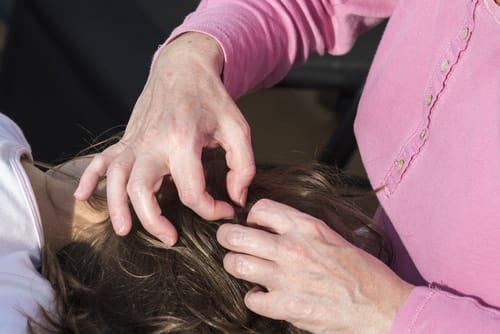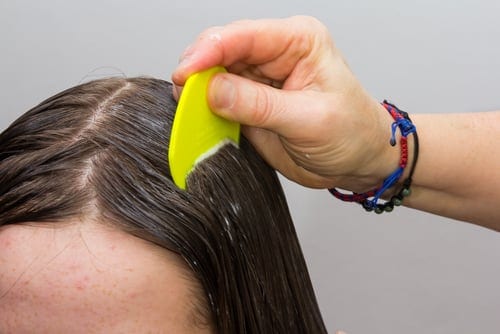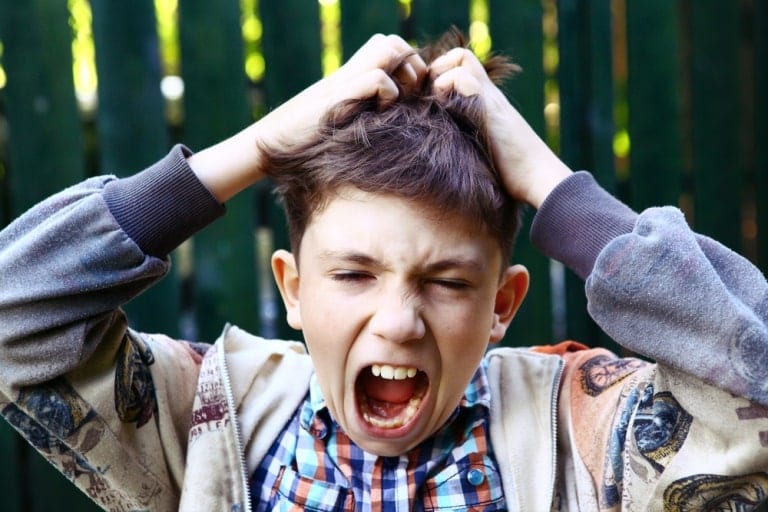Lice are in the news. In fact, in the days leading up to the long-awaited first day of school, the news has been, um, lousy with stories about lice: lice that are resistant to pyrethroids, the active ingredient in most lice shampoos and preparations; and lice that kids get as a result of posing for selfies, with the little buggers jumping from head to head. Parents are freaking out, because if they can’t get rid of the lice, their kids won’t be able to go to school.
Now, I could have written this article as I usually do, by doing research and citing reputable sources, but then I thought, “Heck. If anyone knows about lice, it’s ME.”
After all, I raised 12 children. I’ve been dealing with lice for over 30, backbreaking years of checking heads, nitpicking, and laundering the bedding whenever I found evidence of an infestation. In my area, lice are rather common, so I’ve had to be vigilant and proactive.
Lice Advice
As a result, I’ve learned a lot about lice over the years, so I thought I’d share my accumulated wisdom with you, dear Reader (don’t thank me, I’m a giver—but not of lice!). So here goes:
Don’t use lice shampoos if you’re the allergic type: Anyone who is allergic to chrysanthemums and chamomile tea (like me, for instance, and my kids), should not use lice preparations containing pyrethrins or you’ll break out in uncomfortable little red bumps all over your head. Like ridding your home of rats with hand grenades, or perhaps swatting flies with a sledge hammer.
Don’t use lice shampoo on a regular basis: So let’s say you and your kids aren’t allergic to lice shampoos or preparations—you still don’t want to use them on a regular basis. I did not need a study to tell me that lice become resistant to the shampoos. I’ve seen it with my own eyes. Use it once (meaning: use it, wait two weeks, repeat, as is usually recommended), but then wait until half a year or so has passed before using it again.
Why? Because it simply doesn’t work the second time. The lice get used to it, and it doesn’t kill them anymore. That is what parents in 25 states are now seeing.

Alternate lice preparations: If you don’t want to deal with the lice on your own without shampoos, try a shampoo with a different active ingredient and alternate it with the more usual, more effective pyrethrin-based preparations. This way, the lice won’t become so easily resistant.
Not all lice shampoos are created equal: In theory, it’s a great idea to alternate the types of lice preparations you use, to avoid the issue of lice becoming resistant to the treatments. Unfortunately, the lice preparations that don’t contain pyrethrins aren’t really as effective. In fact, some of them just don’t work and you’ll find you’ve simply thrown away money and wasted time better spent on something else.
Best natural treatment is olive oil and a good lice comb:
1) Apply a liberal amount of olive oil to dry hair (you don’t need your finest extra virgin olive oil for this!) and then comb, comb, comb, going all the way to the end of the hair strands.
2) Each time you pull the comb through the hair, you then pull the comb through a tissue, and then fold the tissue to trap the lice and eggs.
3) When the tissue can’t be folded anymore to hold more lice, throw the folded tissue with its lice and eggs, into a bag.
4) Immediately twist the top of the bag, and fold it under, so the little guys can’t escape.
5) Take a new tissue, and continue.
6) Go around the child’s head, combing from top to bottom until you reach the other side of the child’s head, and then begin again.
7) When you get three clean passes (nothing on the comb or tissue)around the child’s head, you can stop.
8) Rub a liberal amount of shampoo into the child’s oily hair until every part of the hair and scalp is coated with shampoo.
9) Use a little bit of water to begin to make a lather, use just enough water to work up some lather on every part of the head.
10) Rinse clean. The oil comes off easily like this, and the bonus is your child’s hair will be beautifully conditioned.
NOTE: Do not use baby oil, which is not water soluble. I know someone who did this and had oily hair for weeks. Olive oil is the way to go. Trust me on this.
The olive oil method works and it doesn’t expose your child to chemicals. It slows down the lice and helps break the “glue” that connects the unhatched eggs to the hair strands. It is, however, kind of messy. Have your child wear an undershirt and you wear something you don’t care about. Do this in a place such as your bathroom, where the oil won’t get on carpets or upholstered furniture.
Comb often: Lice eggs won’t hatch if you break the seal that connects the eggs to the hair strands. Get yourself a good lice comb. The combs that come with lice shampoos aren’t worth anything. Thrown them out. Invest in a sturdy metal comb with a plastic top. Find a comb that has narrower spaces and wider spaces between the teeth, so you have two combs in one. I like the A-200 Innomed lice comb. Comb every other day, three times a week and you’ll never have a serious lice infestation.

Combing with conditioner: When combing for maintenance purposes—not when your child has an infestation, but just to prevent infestation—try combing after your child has shampooed, and applied conditioner to her wet hair. The conditioner helps you move the comb through the hair without any ouchies.

Teach kids to keep their heads far from other kids’ heads: In my day, there were no selfies. Instead, kids would get lice standing in line for things, like lining up for the school bus or to get food at the school cafeteria. Children often don’t understand the concept of personal space. They may stand too close to the child in front and this is how they get lice. The lice can crawl from one head to another. So teach your child to maintain a distance from other kids’ heads. It’s that simple.
Lice hate dirty hair: Somehow, people have the idea that lice are a sign of being dirty. But in my experience, lice avoid dirty hair and are attracted to clean, shiny, healthy hair. Now, that’s not a reason to eschew shampoo and water. It’s just something to know.
No way around the bedding issue: Lice can’t stay alive too long without hair. But they can stay alive for at least a day with no head in sight. That’s why you have to worry about your child’s bedding, after you’ve cleaned out those lice from her head. You can hang things outside in the sunshine while your child is at school, and this will probably do the trick. But a good washing and a stint in the drier is best. Some parents put blankets and pillows in a tightly closed bag for a day or so, which should kill the lice, since they have no access to a head of hair.
Long hair is easier than short hair for getting rid of lice: Sometimes moms see lice and their first reaction is, HAIRCUT. This is not a good idea. It’s much harder to pull lice off a short strand of hair than off of a long strand of hair. That said, if the hair is very long, that could be difficult for nitpicking, too. Shoulder length is probably best for keeping hair lice-free.
Lice egg colors and what they mean: In my experience, dead lice eggs are whitish, flatter, and dry looking. Technically, you don’t have to worry about them and could leave them in, since they won’t hatch. Lice eggs that can hatch live lice are darker and rounder, and kind of shiny. But the color of both the lice and their eggs seem to adapt a bit to match a child’s hair color. After awhile, you’ll learn to spot them, but it takes some practice.
Always repeat the shampoo treatments: It’s easy to forget to repeat the lice treatments 10 days later. But there’s not much point in using the treatments if you forget the follow-up. The follow-up kills any baby lice that hatch from any remaining eggs after the first treatment and a combing. If you neglect to follow up, you’ll be right back where you started, plus your kid may develop a resistance to the treatment for next time. Kinda pointless, you know?

I believe this is the sum total of what I know about lice to share with you. But if I think of anything, I’ll add an update.
Here’s to lice-free, happy children and a great school year!
Do you have any tips to add? Please leave a comment below. If I like it, I’ll add it and credit you.
Found what you just read useful? Why not consider sending a donation to our Kars4Kids youth and educational programs. Or help us just by sharing!

Hi Varda, what do you think about the listerine lice home remedy? I used this on my son (3rd grade) when he came home with them this past Fall: http://www.homeremediesthatreallywork.com/listerine-lice-treatment-at-home/
It worked great but I had to do it a couple of times to get them all. We don’t have mayo in the house and I heard that works better but I will try olive oil next time!! What about vegetable oil? Would that work?
Hi Valerie,
It sounds like it would be very rough on a child’s delicate skin. Not to mention it could get in a child’s eyes and sting like crazy. You want to use olive oil because it’s good for the hair and scalp and water soluble, too.
Great post! Would you suggest going with an olive oil concentrate, or just the regular virgin olive oil? I have 2 kids at home with head lice, and hopefully I don’t get it next!
Regular olive oil is fine. No need for virgin, either.